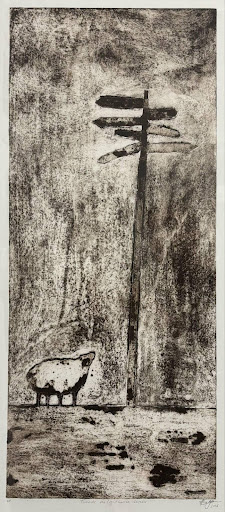What’s in a name?
Alison Bleyerveen
Names have histories and stories and traditions attached to them. Names, and how we are named by and name others, can be life giving or life limiting. Just on a week ago…I was struck by how this can work in practice.
As I watched the election results …Dutton, whatever you think of him…
Albanese, what ever you think of him…
You know…you were there too, how both men made choices about honouring the name and legacy of the other. For me this was a profoundly kind and hopeful moment. It seemed like a god moment. It seemed like it framed, even if only for a few minutes, something possible, something new, a glimpse of a way of being together.
I want us think briefly, and before we do some more work together, about how names and the call to new life, …resurrection life, are reflected in our bible readings today.
The readings we use are set in a liturgical calendar, a lectionary, an order for reading the bible over a 3 year cycle, and in relation to the seasons of the church. We are deep into the season of Easter now, and the focus is on resurrection life. The readings are chosen to reflect this.
At the earliest Luke Acts was written around 80-90 AD, some think later…between 90 and 110, and there’s evidence that leads scholars to think it was still be revised and finalised well into the second century AD.
Johns Gospel is also dated somewhere between AD 85-95, Some of John probably has its origins a bit earlier and it too was being revised until into the turn of the century.
The dating is important because the authors were writing in a time after the fall of the Jewish temple in Jerusalem…the temple had been absolutely central to people’s understanding of faith and identity. And because of this loss, writing at a time when questions about the identity and character of the church were very important too. The idea of the church, as a community of disciples of Jesus, who were living their faith in new ways, that transformed relationships and places, and made a real difference for people now…was taking shape.
In Acts Luke tells the story of a miracle. A woman is dead….the text leaves us no room to doubt that, and then is brought back to life. Its another resurrection story. Interestingly, there aren’t that many of them in the bible. So this one stands out.
It’s always tempting for me to try to explain away miracles…I’ve not experienced one…so it’s tempting to come up with rational explanations like perhaps she was only in a coma, they couldn’t measure brain waves like we can…but the text doesn’t really allow that. She is dead, she has been washed, as was the custom, and she has been laid out in an upper room. Nevertheless, I suspect Luke’s purpose in telling this story is to remind people that from situations of death new life springs and things won’t be the same. Luke is saying to the people of this time…we should expect this! And as we read it today the message remains clear…expect new life to spring up from things that seem dead.
It’s a short passage but much is made of the woman’s name. I think this is important. We hear that she is called Tabitha, and that in Greek her name would be Dorcas. Both Tabitha and Dorcas translate as gazelle. We might imagine a woman of grace and with a liveliness to her. Her character is also emphasised. She is a good woman, a disciple of Jesus, known for her deeds of kindness, particularly with the poor and widowed, and which takes the form of fine dress making, of clothing people. The women, the widows gathered to wash her dead body, were talking about her dressmaking and kindness. We might imagine that knew it first hand.
When Peter is called to this scene of death and remembrance I wonder how he’s feeling? We can imagine his thoughts might be…what do they expect me to do here? We might wonder if Peter remembered other times when he was a follower of Jesus. Perhaps he remembered the healing of the little girl, Jairus’ daughter? In that story Jesus sent everyone out of the room, except Peter and Mark. Jesus spoke the word Talitha cumi. Talitha, meaning little girl, cumi… rise up. Talitha cumi. Peter was one of the only ones Jesus took with him into that bedroom, when Jesus took the girl by the hand, spoke to her, and she was healed.
So I wonder if that was in Peter’s mind. The parallels here are striking. First , like Jesus, he sends everyone else out of the room. He kneels down, closes his eyes and prays. What else can he do when all seems over? We don’t know how long he prayed. And in this story we hear that Peter turns to the body before him in an act of intimacy and faith and like Jesus, speaks to her by name. Tabitha. Tabitha cumi. Tabitha, rise up. And she opens her eyes, takes his hand and sits up.
For me there’s a connection in this story between Tabitha’s name and her character, and also between the naming of Tabitha and the call to embrace new life.
Tabitha’s character and name would go onto be linked in tradition….as Dorcas. Does anyone remember Dorcas pins…used for dressmaking? And as a call to kindness and care for the poor and vulnerable.
But that’s not the end of the story! Luke tells us that word of this death to life story spread and lead to many more people embracing of this new way of living, of being a community of disciples. In the context of the oppressions and cruel deaths of the Romans this story became a powerful sign that death, the apparent ending of things did not have the last word. Tabitha is remembered. And her legacy inspires us still. The seeds of life are in the ending. It is not just Tabitha who cares for the poor and the widows, it is now our name and our calling too.
In John’s Gospel we also hear something of deep knowing and true names. We have before us a short section of a much longer discourse about sheep, shepherds and gates. You know it. IIts where Jesus says, I am the gate. I am the Good Shepherd. It’s a discourse about Jesus’ sense of calling. Jesus is making an identification between his sense of identity and calling and his relationship with God, as well as the relationship God has with us.
I think it’s important to remember that sheep and shepherding in the time of Jesus were understood and experienced differently than we might understand and experience them. Sheep were a way in which wealth was held. The idea of someone having 100 sheep represented almost unimaginable wealth. Shepherds tended to have a small flock and an intimate relationship with each, knowing and calling each by name, and sleeping with them. In Australia, we tend to have huge flocks, and if we know and name sheep at all, it’s usually in rather disrespectful terms….more like get over here you idiot. (Has anyone seen the film Babe!) Treat them mean says Rex….show ‘em who’s boss. Stupid sheep! Or calling people we don’t admire….’sheeple’ because they follow the crowd without thinking.
Theres nothing of this here in John. Jesus says I know my sheep. The Gk word for know used here is OIDA, which carries a sense of being seen and deeply known. A seeing and knowing that goes to the deepest heart of things. This is the knowing of a shepherd who has an intimate relationship and concern for the sheep. It is the knowing of someone who sleeps with the sheep and smells of the sheep. The sheep, in turn, trust the shepherd. They hear the shepherd call their name, they recognise his naming of them as true. They listen to the voice of the shepherd and follow him.
Theres a link for me between this kind of trust and prayer. The kind of trust Peter had in Jesus. Peter, who used to be called Simon, and received a new name Peter, and a command, feed my sheep, care for my lambs, do it because you love me, and I love them. Love them like that. And Peter trusts and prays. Not prayer as in some kind of supernatural wish list or expectation, but prayer as abiding in the loving relationship that Jesus speaks of here. Prayer as in trusting that death will not have the final word, and that we in being known and loved can know and love others. We can listen for Gods voice of love, And we can follow in God’s loving caring footsteps. Like Peter. Like Tabitha. Like those who we have known here at South Sydney. Trevor. Cathie, Andrew. We are one with them and they are one with us, and we can hear their voices in our head as we refuse to let death have the last word and turn to hear Jesus’ voice saying rise up, and follow.
I want to end by sharing with you a poem. It’s by Mary Oliver. It’s about a dog called Benjamin. A dog not a sheep. But we know and love dogs here. Shout out to Lambert and Biggie and Sooty, and all the other dogs known and loved.
“Benjamin, Who Came From Who Knows Where”
By Mary Oliver
What shall I do?
When I pick up the broom
he leaves the room.
When I fuss with kindling he
runs for the yard.
Then he’s back, and we
hug for a long time.
In his low-to-the-ground chest
I can hear his heart slowing down.
Then I rub his shoulders and
kiss his feet
and fondle his long hound ears.
Benny, I say,
don’t worry. I also know the way
the old life haunts the new.
I love the tenderness of these words. And of how they speak of being seen. known, named, touched and called from a past that has hurt into a life of love.
May we know this kind of love. And in listening, trusting, praying learn to name and love others in this way, calling them to new life.




